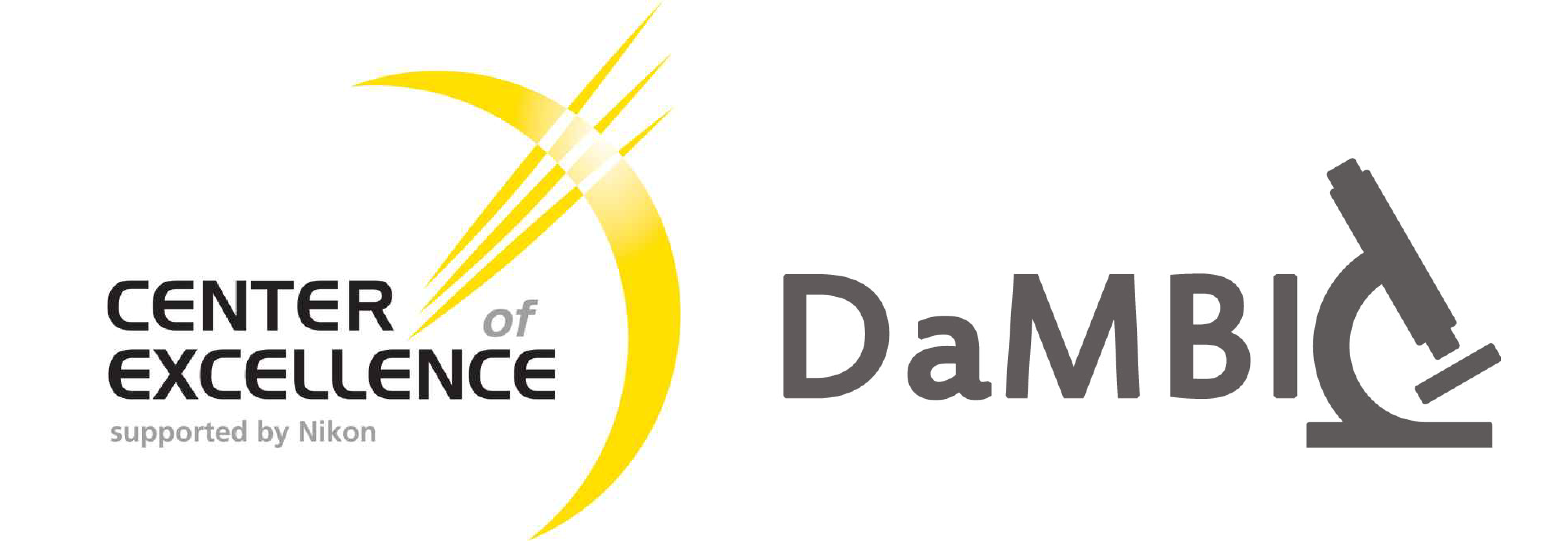Finished PhD and Master projects performed on DaMBIC equipment
PhD Theses
- Anne Sofie Braun Olsen, "Sphingolipid Metabolism and Neurological Dise", 2017. Supervisor: Nils J. Færgeman. pdf
- Eva Bang Harvald, "Systems-wide analyses of starvation responses in metazoans", 2017. Supervisors: Nils J. Færgeman and Martin Røssel Larsen. pdf
- Hanne Engelsby, "Functional analysis of Acyl-coa binding protein in skin and sebaceous glands", 2017. Supervisor: Nils J. Færgeman. pdf
- Mathias P. Clausen, ”Single molecule studies of the lateral organization of the plasma membrane”, 2013. Supervisors: Christoffer Lagerholm & Ole G. Mouritsen. pdf
- Jes Dreier, ”Orientational texture of lipid bilayer and monolayer domains”, 2013. Supervisor Adam Cohen Simonsen. pdf
- Jakub Kubiak, ”Lateral orginization ofof bacterial model membranes”, 2011. Supervisor Luis A. Bagatolli. pdf
Master Theses
- Brian Bjarke Jensen, "Development of Coherent Raman Microscopy for Characterization of Dairy Products", 2018. Supervisor Jonathan R. Brewer. pdf
- Rasmus Grønning, "Visualization and Quantitative Analysis of Nuclear Shuttling of Carbohydrate Response Element Binding Protein (ChREBP) in Pancreatic Beta Cells", 2018. Supervisor Daniel Wüstner. pdf
- Suzanna Cieslak Frank Frederiksen, "Evaluation of skin perforation by laser ablation and microneedle treatment", 2018. Supervisors Jonathan R. Brewer and Judith Kuntsche.
- Nadia Guldfeldt Bæk, "Influence of liposomal formulations on the lipid organization in human stratum corneum", 2018. Supervisors Judith Kuntsche and Jonathan R. Brewer.
- Petya Popova. ”Developing electrostatic complexes for co-delivery of siRNA and anticancer drugs”. 2017. Supervisor Eva Arnspang Christensen.
- Martine Khataei Notabi. "A Study of Antibody Conjugated Nanoparticles as a Drug Delivery System for Cancer Therapy by Active Targeting". 2017. Supervisor Eva Arnspang Christensen.
- Emma Pipó Ollé. ”Microscopy of lipid changes in Stem Cells to investigate the uptake and response of Falcarindiol". 2017. Supervisor Eva Arnspang Christensen.
- Maximilian Matthies, "Bioimaging and quantitative proteomics of the acquired middle ear disease cholesteatoma", 2017. Supervisor Jonathan R. Brewer. pdf
- Irina-Elena Antonescu, ”Effect of penetration enhancers on the archetecture and barrier function of human skin”, 2016. Supervisors Jonathan R. Brewer and Judith Kuntsche. pdf
- Mie Thorborg Pedersen, ”A gastrophysical investigation of moon jellyfish (Aurelia aurita)”, 2016. Supervisors Per Lyngs Hansen & Jonathan R. Brewer. pdf
- Bjarne Thorsted, ”Characterization of fluorophores for two-photon and STED microscopy in tissue”, April 2015. Supervisor Jonathan R. Brewer. pdf
- Jonas Camillus Jeppesen, ”Simulation and experimental study of texture in domains in lipid bilayers”, February 2014. Supervisors Per Lyngs Hansen, Adam Cohen SImonsen & Jonathan R. Brewer. pdf
Bachelor Theses
- Katharina Nielsen, "A Microscopic Investigation of Transdermal Distribution of Drug Analogues", 2018. Supervisors Judith Kuntsche and Jonathan R. Brewer, pdf
- Ditte Bork Iversen, "Transdermal penetration of drug-analogues by the use of a dermaroller", 2018. Supervisors Judith Kuntsche and Jonathan R. Brewer, pdf
- Emma Pipó Ollé. ”Microscopy of lipid changes in hMSC cells to investigate the uptake and response of falcarindiol”. 2016. Supervisor Eva Arnspang Christensen.
- Homa Hotaki, ”Transdermal penetration”, May 2016. Supervisor Jonathan R. Brewer. pdf
- Suzanna Cieslak Frank Frederiksen, ”The effect of GMO nanoparticles on skin structure and penetration of a model compound by CARS and fluorescence microscopy”, May 2016. Supervisors Judith Kuntsche and Jonathan R. Brewer. pdf
- Roghieh Yuusufi, ”Transdermal penetration”, May 2016. Supervisor Jonathan R. Brewer. pdf
- Marlene Storm Andersen, ”Transdermal penetration”, May 2016. Supervisor Jonathan R. Brewer. pdf
- Nhi Phuong Thi Nguyen, ”Transdermal penetration”, May 2016. Supervisor Jonathan R. Brewer. pdf
- Marie Karen Tracy Hong Lin, ”Comparison of the structure in human skin and acquired cholesteatoma”, August 2015. Supervisor Jonathan R. Brewer. pdf
- Irina Iachina, ”STED microscopy in human skin”, August 2015. Supervisor Jonathan R. Brewer. pdf
Other Student Projects
- Marie Karen Tracy Hong Lin. 10 ECTS ISA (individual student activity). ”Bioimaging and lipid analysis of human epidermis and cholesteatoma”. Acquired cholesteatoma is characterized by uncontrolled growth of keratinizing squamous epithelium in the middle ear. Studies showed difference in the lipid composition between the human skin and acquired cholesteatoma. High Performance Liquid Chromatography (HPLC) and mass spectrometry were thus used to measure and identify the lipid composition in acquired cholesteatoma for comparison against the human epidermis. Confocal fluorescence microscopy was used to visualize the structures after labeling specific proteins using immunocytochemistry techniques. 2016. Supervisor Jonathan R. Brewer.
- Marie Karen Tracy Hong Lin. 15 ECTS ISA (individual student activity). ”CARS imaging of glucose uptake in the arterial wall”. Diabetes, obesity and dyslipidemia are all shown to be characterized by endothelial dysfunction of the arterial wall. To develop a protocol for imaging the glucose uptake in arterial wall, Coherent anti-Strokes Raman (CARS) microscopy was used to visualize d7-glucose uptake in the wall of resistance arteries. d7-glucose was used to differentiate between glucose already in the sample and glucose added. 2016. Supervisor Jonathan R. Brewer.
- Brian Bjarke Jensen. 10 ECTS ISA (individual student activity). "Diver" project". Implementation of New Methods for Deep Tissue Imaging. To be able to "look" deeper inside tissue, a new method has been developed. This method is a combination of Fluorescence-lifetime imaging microscopy (FLIM) and Two-photon laser scanning microscope and is known as deep tissue imaging microscopy (DIVER) and takes into account the intense scattering of light that is produced by the tissue. This new method claims to be able to visualize structures as deep as 3 mm inside of a sample. 2016. Supervisor Jonathan R. Brewer.
